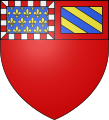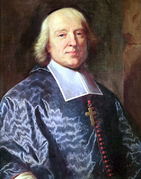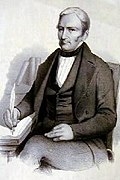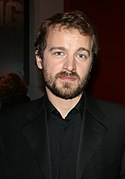Dijon
| Dijon | ||
|---|---|---|

|
|
|
| region | Bourgogne-Franche-Comté | |
| Department | Côte-d'Or ( prefecture ) | |
| Arrondissement | Dijon | |
| Canton |
Chief lieu of Dijon-1 Dijon-2 Dijon-3 Dijon-4 Dijon-5 Dijon-6 |
|
| Community association | Dijon metropolis | |
| Coordinates | 47 ° 19 ' N , 5 ° 3' E | |
| height | 220-410 m | |
| surface | 40.41 km 2 | |
| Residents | 156,920 (January 1, 2017) | |
| Population density | 3,883 inhabitants / km 2 | |
| Post Code | 21000 | |
| INSEE code | 21231 | |
| Website | www.dijon.fr | |
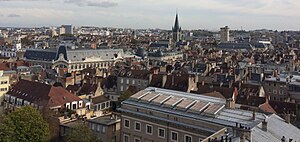 Dijon |
||
Dijon [ diˈʒɔ̃ ] ( ; German out of date: Dision , Italian Digione , Latin Divio , Diviodunum ) is a city with 156,920 inhabitants (as of January 1, 2017) in eastern France , capital of the Côte-d'Or and the Capital of the Bourgogne-Franche-Comté region .
Dijon is a traffic, commercial and industrial center and seat of the Université de Bourgogne , which was founded in 1722. The city is famous for its mustard and an important trading post for Burgundy wines .
geography
Dijon is on the western edge of the Saône plain and at the foot of the northern foothills of the Côte; The Ouche flows through the city , it lies on the Canal de Bourgogne , which connects the city with the Saône.
history
The earliest finds in the area of today's city of Dijon date from the Hallstatt Period, an era of the Iron Age .
The Romans expanded the small camp on Via Agrippa and called it Divio , in Celtic Diviodunum , Divionum or Castrum divionense . It belonged to the province of Gallia Belgica . It was on the Roman road between Lyon (Latin / Celtic Lugdunum ) and Trier ( Augusta Treverorum ). Due to persistent Germanic invasions, the city was fortified by the Romans in 273. It is believed that the missionary Benignus of Dijon , who had worked in this city for a long time, was martyred at this time .
In 500 the Franks under Clovis I defeated the Burgundians under Gundobad in the battle of Dijon .
Later Dijon came under the rule of the diocese of Langres , from which it was fiefied by the Counts of Dijon and after the death of the last of them (1007) to the Dukes of Burgundy , who made it their residence. In 1016 the town came into the possession of King Robert II the Pious , who incorporated it into the Duchy of Burgundy . Three church assemblies (Concilia Divonensia), 1077, 1116 and 1199, were held in Dijon.
On June 28, 1137, a conflagration destroyed the city, which was rebuilt under Duke Hugo II. Duke Hugo III. Dijon became a city in 1187 and the suburb of Saint-Bénigne was surrounded by a city wall and incorporated. During this time the Charité hospital was founded.
After Philip I of Burgundy died in 1361, the King of France handed over the Duchy of Burgundy, with Dijon as the capital, to his son, Philip the Bold, in 1363 . In 1377 he acquired some land outside the city gates and in 1384 built the Chartreuse de Champmol , a Carthusian monastery and the future burial place of the Dukes of Burgundy.
After the death of Charles the Bold, Dijon and Burgundy went to France in 1477, and King Louis XI. established the Parliament for Burgundy here. The city surrendered to Switzerland in the Dijon procession in 1513 .
In the 17th and 18th centuries it began to grow into a big city. The university was founded in Dijon in 1722. In 1725 the city received a bishopric again. In 1740 the Burgundy Parliament established the Academy of Sciences, Arts and Literature. In addition, a botanical garden and a natural history museum were set up at this time.
On July 18, 1766, Wolfgang Amadeus Mozart - he was ten years old at the time - made a guest appearance in the city with his father and sister on the occasion of a visit to the governor . They gave a concert together.
In the 19th century the city grew again. The demolition of the old fortifications became necessary. In 1833 the Canal de Bourgogne was completed. In 1844 the first rail connections to Dijon were laid. In 1899 the city was accepted into the Legion of Honor ( Légion d'honneur ), which resulted in a change in the city's coat of arms.
In 1940 the city was bombed and occupied by the German Wehrmacht . Three of the planes that were supposed to bomb Dijon disappeared and mistakenly bombed Freiburg im Breisgau . On September 11, 1944, the city was liberated again.
In 1964, the Lac Chanoine Kir reservoir , named after the mayor at the time , was created just outside the city to the west and is now an important local recreation area. In 1981 it was connected to the TGV network of the French railways.
population
Development of the population:
- 1968: 145.357
- 1975: 151.705
- 1982: 140.942
- 1990: 146.703
- 1999: 149.867
- 2006: 151.504
- 2012: 152.071
politics
Town twinning
Dijon is one of the cities with the largest number of twinning cities in France. It was one of the first French cities to become siblings with a German city at the end of World War II . Most of these town twinning agreements were established in the 1950s and 1960s by the then mayor and canon Félix Kir . The city currently lists a total of ten twin cities:
| city | country | since |
|---|---|---|
| Cluj-Napoca (Klausenburg) |
|
1965 |
| Dallas |
|
1957 |
| Guimarães |
|
|
| Mainz |
|
1958 |
| Opole (Opole) |
|
2003 |
| Pécs |
|
1966 |
| Reggio nell'Emilia |
|
1963 |
| Skopje |
|
1961 |
| Volgograd |
|
1960 |
| York |
|
1953 |
coat of arms
Blazon : "Red with a split shield head, in front within a silver-red decorated border blue sprinkled with golden heraldic lilies, in the back within a red border five times divided by gold and blue diagonally to the right."
Coat of arms history: Until 1391 the coat of arms of the city was single red in the old French triangular shield . In the same year, today's coat of arms with the colors of the Duke of Burgundy, Philip II the Bold, was introduced in the shield head.
During the reign of Napoléon Bonaparte , the city's coat of arms changed as a city of the first order ( Napoleonic heraldry ):
"Under a red shield head, three golden bees , divided, in front within a silver-red border in blue a golden vine with four leaves and two vines, at the back within a red border five times divided diagonally by gold and blue." In French heraldic shield (18th and 19th centuries).
After that, the city again carried its current coat of arms, which was extended in 1899 to include the order cross of the Legion of Honor from the shield head hanging without a ribbon. In 1962 the cross was placed under the shield as an order , d. i.e. it only appears in the large city arms with the splendid pieces , the shield itself has its old form from 1391 again.
Cityscape
The former ducal palace on the semicircular, colonnaded Place de la Liberation is still the center of the city, dates from the late 17th century and today houses the town hall in the west wing . The 46 meter high Tour Philippe-le-Bon dates from the 15th century. In the quarter around the Ducal Palace there are beautiful patrician houses (hôtels) from the Middle Ages and the Renaissance. The Palace of Justice dates from the 15th and 16th centuries and was originally the seat of the Court of Justice of Burgundy. The Gothic cathedral of Dijon was built from 1271 to 1325 after the collapse of the previous building from the 11th century; The remains of this can be seen in the crypt where Saint Benignus of Dijon , one of the great missionaries of Burgundy, is buried. An archaeological museum is housed in the preserved monastery buildings. The church Notre-Dame was built in 1220-1250 in the style of Burgundian Gothic. The late Gothic Saint-Michel church was built between 1499 and 1525 and is the largest parish church in Dijon; it contains numerous works of art. The St. Bernard convent church is a splendid Italian baroque building and houses a museum of sacred art. Folklore exhibits are shown in the former convent buildings. There are only remnants of the Chartreuse de Champmol , built as the burial place of the dukes; The sculptures of the Moses well and the chapel portal decorated with statues by Claus Sluter from the 15th century are preserved. The figures of the prophets and mourning angels were groundbreaking for the development of sculpture in Burgundy. The synagogue from the 19th century was saved from destruction by Félix Kir. Opened in 1880, Jardin Darcy is the city's oldest public park.
Museums
Dijon is home to well-known museums that present important regional collections. They are all housed in cultural monuments.
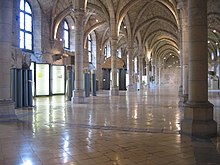
- The art museum is one of the oldest museums in France. It houses works of art from ancient Egyptian times to the 20th century and is housed in the former palace of the Dukes of Burgundy.
- The archaeological museum is housed in the remains of the collegiate church of St. Benigne. Finds from Roman times and the Middle Ages are presented here. The Christ head of the planned cross for the Moses fountain by Claus Sluter from the Chartreuse de Champmol is exhibited here.
- The Musée de la Vie Bourguignonne Perrin de Puycousin is located in the cloister of the Monastère des Bernardines . It presents a collection of rural and urban life in Burgundy from everyday life from the 18th to the beginning of the 20th century.
- The Musée d'art sacré de Dijon is also located within the walls of the Monastère des Bernardines . It shows a collection of liturgical objects. The highlight is the sculpture "The Visitation", from the destroyed monastery of the same name.
- The Musée Magnin has an impressive collection of paintings and furniture collected by Maurice Magnin and his wife Jeanne. It is located in the former Hôtel Lantin, a 17th century Hôtel particulier , rue des Bons Enfants.
- The Musée François Rude is located in the transept of the secular church of Saint-Étienne. It houses various casts of busts and statues by the sculptor François Rude .
- The buildings of the Natural History Museum - Planetarium - Garden of Science are part of the collections of the Arquebuse Botanical Garden.
- Until 2006 there was still the mustard museum Musée de la moutarde de Dijon (Musée Amora), which was located on the grounds of Amora .
Regular events
- Jazz en Ville , "Jazz in the City", takes place annually in May.
- Théâtre en Mai , “Theater in May”, takes place annually.
- L'Eté Musical , "Summer of Music", takes place annually in June.
- Estivade , a festival of theater, song and dance in the squares and streets of Dijon, takes place every June.
- Ecrans de l'Aventure , is a festival of adventure films and takes place every September.
- Open du Rock is a rock festival that takes place every September.
- Festival Nouvelles Scènes , “Festival of New Scenes” is a theater festival that takes place every autumn.
economy
The city's economy is highly diversified . In addition to the food industry, metal processing, the chemical industry and the pharmaceutical industry are important.
From the formerly flourishing production of Dijon mustard with over 40 companies, only three medium-sized companies remained in 2012. The last major manufacturer, Amora , has now also been bought up by a group, which in return moved its development laboratory to Dijon in 2005. The production of mustard seeds has moved from Burgundy to Canada, where production is much cheaper; so there z. B. sown by plane.
Of the former food factories, only grain mills remain today. But there are also new operations, for example Nestlé has opened a large chocolate bar factory.
The wine trade for the entire region runs more quietly here, production and handling take place in the nearby winegrowers and bottling plants on the Côte-d'Or.
The chemical industry focuses on plastics processing, the smaller manufacturing companies cannot grow due to the very cramped conditions within the city and cannot finance the move to a new environment, partly because the requirements for environmental protection and occupational safety have increased enormously .
The largest operation in the pharmaceutical industry was recently taken over by a group and is now starting to adapt to the new circumstances, which will involve significant changes.
The mayor succeeded in working with the surrounding communities to create an economic region in which, among other things, Japanese suppliers to the automotive industry could settle.
traffic
Already in Roman times Dijon was on an important trunk road, the remains of which have been preserved north of the city near Bretigny. Today Dijon is located on the Autoroute A 31 ( Beaune - Luxembourg ) and is the starting point for the A 38 to Paris and the A 39 towards Bourg-en-Bresse .
As one of the main railway hubs in the country, Dijon has two long-distance train stations for passenger transport: Dijon-Ville , on the Paris-Marseille railway line , with TGV services from Besançon or Bern and Geneva to Paris (journey time 1:40 hours) and other connections to Bourg -en-Bresse and Dole, as well as Dijon Porte Neuve for the trains to Langres. On top of the southern wine-growing town of Dijon -Gevrey Chambertin the marshalling yard "Gevrey Triage". In the next few years, as part of the new / expansion project LGV Rhin-Rhône, the connection to the main Paris-Lyon-Marseilles ( LGV Sud-Est ) line is to be significantly improved and travel times to Mulhouse and Strasbourg are to be shortened considerably.
Local public transport in the greater Dijon area is currently carried by 21 bus routes, which transport around 146,000 people every day. Due to the high utilization of the seven main lines (“Lianes” - Lignes à niveau élevé de service), the city has received two tram lines (→ Tram Dijon ). The T1 line has been running from the main station to Quetigny (8.5 km) since September 1, 2012 . The T2 line has been connecting the southern suburb of Chenôve with the Parc Valmy business park in the north of the city (11.5 km) since December 8, 2012 .
Dijon-Bourgogne Airport is located southeast of the city near Longvic, and Dijon-Darois Airport is northwest .
education
- University of Burgundy
- Ecole des beaux arts
- Burgundy School of Business (Ecole supérieure de commerce de Dijon)
- Conservatoire d'art dramatique
Personalities
- Thoinot Arbeau (1519–1595), choreographer, Catholic priest and canon of Langres
- Claude Balbastre (1724–1799), composer and organist
- Henry of Burgundy (1069–1112), Count of Portugal and ancestor of the House of Burgundy
- Étienne Heudelet de Bierre (1770–1857), general
- Maurice Blondel (1861–1949), philosopher
- Maurice Boitel (1919–2007), painter
- Jacques Bénigne Bossuet (1627–1704), theologian, bishop and writer
- Jean Bouhier (1673–1746), scholar and member of the Académie française
- Étienne Cabet (1788–1856), publicist, politician and revolutionary
- Lucien Cailliet (1891–1985), composer and clarinetist
- Johanna Franziska von Chantal (1572–1641), saint of the Catholic Church
- Paul Charles Chocarne-Moreau (1855–1930), genre painter
- Claude Courtépée (1721–1781), worked as professor and prefect of studies at the Collège des Godrans in Dijon
- Henry Darcy (1803–1858), engineer who dealt with the flow of porous media and found a linear relationship for laminar flow
- Louis Deibler (1823-1904), executioner
- Henri François Delaborde (1764–1833), Revolutionary General
- Gustave Eiffel (1832-1923), engineer
- Édouard Estaunié (1862–1942), French writer
- Isabelle Ferrer (* 1974), triathlete
- Christophe Fiatte (1967-2015), football player
- Maurice Gaidon (1928–2011), Roman Catholic bishop
- Edouard Giroux (1871–1949), racing car driver
- Jérôme Golmard (1973-2017), tennis player
- Charles Gravier, comte de Vergennes (1717–1787), statesman
- Roger Charles Louis Guillemin (* 1924), French-American biochemist
- Claude Jade (1948–2006), actress
- Johann Ohnefurcht (1371–1419), Duke of Burgundy
- Jean-Claude Justice (1949–1999), racing car driver
- Félix Kir (1876–1968), canon and former mayor of the city (inventor of the Kir and Kir Royal)
- Charles the Bold (1433–1477), last Duke of Burgundy
- Bernard de La Monnoye (1641–1728), poet, scholar and member of the Académie française
- Anne Lauvergeon (* 1959), manager
- Hugues-Bernard Maret (1763–1839), statesman and publicist
- Edme Mariotte (around 1620–1684), physicist
- Alexis Miellet (* 1995), track and field athlete
- Mathurin Moreau (1822–1912), sculptor
- Claude Louis Marie Henri Navier (1785–1836), mathematician and physicist
- Pierre Cardinal Petit de Julleville (1876–1947), Archbishop of Rouen
- Anne Plichota (* 1968), author of children's books
- Philip the Good (1396–1467), Duke of Burgundy
- Alexis Piron (1689–1773), lawyer and writer
- Nelly Pouget (* 1955), jazz musician and composer
- Jocelyn Quivrin (1979–2009), actor
- Jean-Philippe Rameau (1683–1764), composer and theorist
- Virginie Razzano (* 1983), tennis player
- François Rebsamen (* 1951), mayor
- François Rude (1784–1855), sculptor
- Gaspard de Saulx, seigneur de Tavannes (1509–1573), general and marshal of France
- Théodore Simon (1873–1961), physician and inventor of an intelligence test
- Laurent Ulrich (* 1951), Roman Catholic clergyman, Archbishop of Lille
- Jean-Baptiste Philibert Vaillant (1790–1872), General and Marshal of France
- Eugène Verpault (1885–1980), racing car driver
- Virginie Viard (* 1962), costume and fashion designer
Web links
- City of Dijon
- Dijon metropolis. Tourist information in German. In: de.destinationdijon.com. Office du Tourisme, accessed on February 18, 2020 .
Individual evidence
- ^ Studies on the Burgundian history of Hans Erhard Düsch - Karl Schneider - 1910
- ^ Liberation of Dijon on September 11, 1944. (French)
- ↑ Ville de Dijon - Dijon, une politique renouvelée à l'international . Archived from the original on October 2, 2013. Info: The archive link was inserted automatically and has not yet been checked. Please check the original and archive link according to the instructions and then remove this notice. Retrieved December 14, 2014.
- ↑ Ville de Dijon - Jumelages . Archived from the original on June 2, 2013. Info: The archive link was inserted automatically and has not yet been checked. Please check the original and archive link according to the instructions and then remove this notice. Retrieved December 14, 2014.
- ↑ Ville de Dijon - Villes partenaires de Dijon . Retrieved December 14, 2014.
- ^ Alfred Pletsch: France. Scientific Book Society, Darmstadt 2003, ISBN 3-534-16042-8 , p. 135.
- ↑ Dossier relatif aux musées de la Ville de Dijon en ligne
- ^ Site du Musée des Beaux-Arts de Dijon
- ↑ Divia: Divia en chiffres ( Memento of the original from March 30, 2009 in the Internet Archive ) Info: The archive link was automatically inserted and not yet checked. Please check the original and archive link according to the instructions and then remove this notice.
- ↑ Ville de Dijon - Les transports: Cap sur le Grenelle de l'environnement




